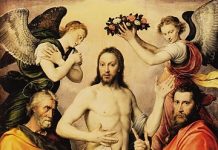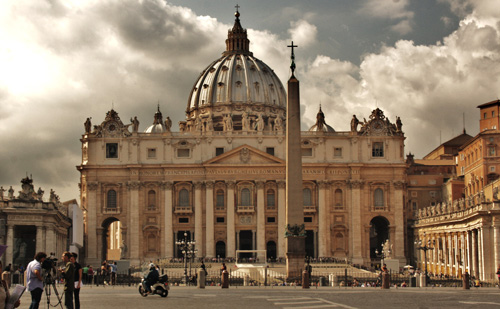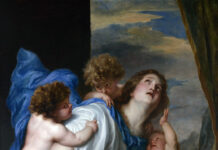(Karol Wotyla did his theological doctorate on the mystical poetry of Saint John of the Cross, so he writes here not only as Pope, but as one who has delved deeply in into the thought of this great Carmelite saint).
Pope John Paul II
Apostolic Letter Of His Holiness John Paul II
To The Very Reverend Father Felipe Sainz De Baranda Superior General Of The Order Of The Discalced Brothers Of The Blessed Virgin Mary Of Mount Carmel On The Occasion Of The IV Centenary Of The Death Of Saint John Of The Cross, Doctor Of The Church
I Introduction
1. Master in the faith and witness to the living God, Saint John of the Cross is present in the memory of the Church, especially today as we celebrate the IV Centenary of his passing to glory, which took place on 14 December 1591, when he was called from his convent of Ubeda to the house of the Father.
The Church finds joy in attesting to the abundant fruits of holiness and wisdom that this her son continues to bear through the example of his life and the light of his writings. Indeed, his person and his teachings draw the interest of people from the most diverse religious and cultural surroundings. He understands them and speaks to the deepest aspirations of the human person and of the believer. Therefore, I cherish the hope that this jubilee celebration may serve to increase the lustre of his central message—the theological life in faith, hope and love—and to make it more widely known.
This message, meant for everyone, is the special heritage of the Teresian Carmel which rightly considers St. John of the Cross its Father and Spiritual Master. It is also its pressing task. John’s example makes him the pattern of Carmelite life. His writings are a treasure to be shared with all those who seek the face of God today. His doctrine speaks to our times, most especially in Spain, his native land, whose literature and name he honors with his magisterium of universal reach.
2. I myself have been especially attracted by the experience and teachings of the Saint of Fontiveros. From the first years of my priestly formation, I found in him a sure guide in the ways of faith. This aspect of his doctrine seemed to me to be of vital importance to every Christian, especially in a trail-blazing age like our own which is also filled with risks and temptations in the sphere of faith.
Europe was still bathed in the afterglow of the celebration of the fourth centenary of the birth of the Carmelite Saint (1542-1942) and rising from its ashes after the dark night of war when, in Rome, I wrote my doctoral thesis in theology on the subject of Faith according to St. John of the Cross (1). In it, I devoted special attention to an analytical discussion of the central affirmation of the Mystical Doctor: Faith is the only proximate and proportionate means for communion with God. Even then I felt that John had not only marshalled solid theological doctrine, but that, above all, he had set forth Christian life in terms of such basic aspects as communion with God, the contemplative dimension of prayer, the strength that apostolic mission derives from life in God, and the creative tension of the Christian life lived in hope.
During my November 1982 visit to Spain, I had the joy of extolling the Saint’s memory against the evocative backdrop of the Roman aqueduct at Segovia. I visited his tomb and venerated his remains. There I once again voiced the great message of faith, the essence of his teaching for the Church, for Spain and for Carmel: the message of a vigorous, living faith which seeks and finds God in His Son Jesus Christ, in the Church. in the beauty of creation, in quiet prayer, in the darkness of night, and in the purifying flame of the Spirit (2).
3. It is fitting, as we celebrate the fourth centenary of his death, that we should once again sit at the feet of this Master. By a happy coincidence, he is our traveling companion for this crossroads of history at which we stand. We are at the threshold of the year 2000. Twenty-five years separate us from the closing of the Second Vatican Council which began and sustained the renewal of the Church in her purity of doctrine and sanctity of life. As the Council affirms, “It is the function of the Church to render God the Father and his incarnate Son present and as it were visible, while ceaselessly renewing and purifying herself under the guidance of the Holy Spirit. This is brought about chiefly by the witness of a living and mature faith, namely, one that is so well formed that it can see difficulties clearly and overcome them” (3).
The presence of God and of Christ, a renewing purification under the guidance of the Spirit, and the living of an informed and adult faith—is this not in reality the heart of the teaching of St. John of the Cross and his message for the Church and for men and women of today? Unless we renew our faith and brighten its flame, we will not be able to face any of the great tasks which face the Church. Only faith enables us to experience the salvific presence of God in Christ in the very centre of life and of history. Faith alone reveals to us the meaning of the human condition and our supreme dignity as sons and daughters of God who are called to communion with Him (4). Faith is the heartbeat of the new evangelization, for it re-evangelizes believers and opens them more and more to the teachings and light of Christ.
4. St. John of the Cross is known in the Church and in the world of culture for many things. He is a man of letters and a poet of the Castilian language. He is an artist and humanist. He is a man of deep mystical experiences. He is a theologian and spiritual exegete. He is a spiritual master and director of consciences. As a master or guide on the journey of faith, he brings light, through his example and doctrine, to all those who seek to experience God through contemplation and through self-sacrificing service to their brothers and sisters. In his elevated poetical production and doctrinal tracts—The Ascent of Mt. Carmel, The Dark Night, The Spiritual Canticle, and The Living Flame of Love—as well as in his brief and pithy writings—The Sayings of Light and Love, The Counsels, and his letters—the Saint has left us a great synthesis of spirituality and of Christian mystical life. Yet from among this rich fare set forth by him, I wish to fix our attention on his central message: living faith which is the guide of the Christian, his only light in the dark nights of trial, an ardent flame fed by the Spirit.
Faith, as the Saint so well shows by his life, inspires adoration and praise. It anchors every human person in a real world permeated with the presence of surpassing realities. Therefore I wish, with the light of “the Holy Spirit who is the Teacher” (5) and in harmony with the sapiential style of Friar John of the Cross, to comment upon some aspects of his doctrine touching on faith. I want to share his message with the men and women who are living today at this hopeful and challenging hour of history.
The historical context
5. It fell to Friar John of the Cross to live in historical circumstances that offered him rich possibilities which spurred the full development of his faith. During his lifetime (1542-
1591), an intense and creative religious age begins in Spain, Europe, and America. It is the age of the evangelical expansion of the Catholic Reform. It is also a time of accord, of ruptures in the unity of the Church, and of internal and external conflicts. The critical juncture urges a response. The Church holds a great Council to teach and reform, the Council of Trent. She evangelizes a new continent, America. She invigorates the Christian roots of an old world, Europe.
These situations and events mark out the context in which the life of John of the Cross unfolds. He spends his childhood and youth in extreme poverty and has to make his way by working with his hands in Fontiveros, Arevalo and Medina del Campo. He follows a Carmelite calling and receives a higher education in the halls of the University of Salamanca. Immediately alter a providential meeting with Saint Teresa of Jesus, he embraces the Reform of Carmel and begins a new form of life in the first convento of Duruelo. The first male Discalced Carmelite, he shares the ups and downs and difficulties of his religious family as it comes to birth. Imprisonment in Toledo, the solitude of El Calvario and La Penuela in Andalusia, his apostolate in the monasteries of nuns, and his work as Superior weather him. His mature personality emerges in a lyric outpouring of poetry, in his written commentaries, in his simple conventual life, and in his itinerant apostolate. Alcala de Henares, Segovia and Ubeda are names which evoke the fullness of his interior life, of his priestly ministry, and his spiritual magisterium.
This rich experience enables him to face the state of the Church of his time with an open attitude. He is aware of what is taking place. In his writings he alludes to heresies and errors. At the end of his life he offers to go to Mexico to preach the Gospel. He is preparing to carry out his purpose when sickness and death cut him short.
6. John de Yepes’ response to the grave spiritual needs of his time is to embrace a contemplative vocation. He is not washing his hands of his human and Christian responsibilities. On the contrary, in taking this step he is committing himself to living with full awareness the very heart of the faith by seeking the face of God, by listening to His word and putting it into practice, and by surrendering himself to the service of his neighbor.
John shows us that the Christian can find complete fulfilment in the contemplative life. The contemplative does not limit himself to spending long stretches in prayer. The companions of the Carmelite Saint and his biographers give us a dynamic picture of him. As a youth, John learned to nurse the sick and to lay bricks and stones and to work in the orchard and adorn the church. As an adult, he discharges responsibilities in government and formation, attentive always to the spiritual and material needs of his brethren. He goes on long journeys by foot in order spiritually to assist his sisters, the Discalced Carmelite Nuns, for he is convinced of the value of their contemplative life for the Church. His attitude may be summed up by a basic conviction: It is God and God alone that gives value and meaning to every activity, “For where God is unknown, nothing is known” (6).
His special vocation as a contemplative Carmelite enabled him to serve the Church and her needs in the best way through his life and writings. And so Friar John lived in the company of his brothers and sisters in Carmel in prayer and silence, in service and sober simplicity and renunciation which were steeped in faith, hope and love. With St. Teresa of Jesus, he realized and shared the fullness of the Carmelite charism. Together they continue to be in the Church eminent witnesses of the living God.
The task of forming believers
(To continue reading, please see here).












